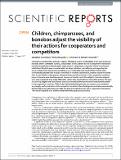Files in this item
Children, chimpanzees, and bonobos adjust the visibility of their actions for cooperators and competitors
Item metadata
| dc.contributor.author | Grueneisen, Sebastian | |
| dc.contributor.author | Duguid, Shona | |
| dc.contributor.author | Saur, Heiko | |
| dc.contributor.author | Tomasello, Michael | |
| dc.date.accessioned | 2020-01-29T13:30:02Z | |
| dc.date.available | 2020-01-29T13:30:02Z | |
| dc.date.issued | 2017-08-17 | |
| dc.identifier | 265941669 | |
| dc.identifier | ee5dc4de-4390-44c2-9f9c-0dbc1b63a4d2 | |
| dc.identifier | 85027858149 | |
| dc.identifier | 28819263 | |
| dc.identifier.citation | Grueneisen , S , Duguid , S , Saur , H & Tomasello , M 2017 , ' Children, chimpanzees, and bonobos adjust the visibility of their actions for cooperators and competitors ' , Scientific Reports , vol. 7 , 8504 . https://doi.org/10.1038/s41598-017-08435-7 | en |
| dc.identifier.issn | 2045-2322 | |
| dc.identifier.other | ORCID: /0000-0003-4844-0673/work/67919867 | |
| dc.identifier.uri | https://hdl.handle.net/10023/19376 | |
| dc.description.abstract | Chimpanzees and bonobos are highly capable of tracking other's mental states. It has been proposed, however, that in contrast to humans, chimpanzees are only able to do this in competitive interactions but this has rarely been directly tested. Here, pairs of chimpanzees or bonobos (Study 1) and 4-year-old children (Study 2) were presented with two almost identical tasks differing only regarding the social context. In the cooperation condition, players' interests were matched: they had to make corresponding choices to be mutually rewarded. To facilitate coordination, subjects should thus make their actions visible to their partner whose view was partially occluded. In the competition condition, players' interests were directly opposed: the partner tried to match the subject's choice but subjects were only rewarded if they chose differently, so that they benefited from hiding their actions. The apes successfully adapted their decisions to the social context and their performance was markedly better in the cooperation condition. Children also distinguished between the two contexts, but somewhat surprisingly, performed better in the competitive condition. These findings demonstrate experimentally that chimpanzees and bonobos can take into account what others can see in cooperative interactions. Their social-cognitive skills are thus more flexible than previously assumed. | |
| dc.format.extent | 10 | |
| dc.format.extent | 1342330 | |
| dc.language.iso | eng | |
| dc.relation.ispartof | Scientific Reports | en |
| dc.subject | BF Psychology | en |
| dc.subject | DAS | en |
| dc.subject.lcc | BF | en |
| dc.title | Children, chimpanzees, and bonobos adjust the visibility of their actions for cooperators and competitors | en |
| dc.type | Journal article | en |
| dc.contributor.institution | University of St Andrews. School of Psychology and Neuroscience | en |
| dc.identifier.doi | https://doi.org/10.1038/s41598-017-08435-7 | |
| dc.description.status | Peer reviewed | en |
This item appears in the following Collection(s)
Items in the St Andrews Research Repository are protected by copyright, with all rights reserved, unless otherwise indicated.

